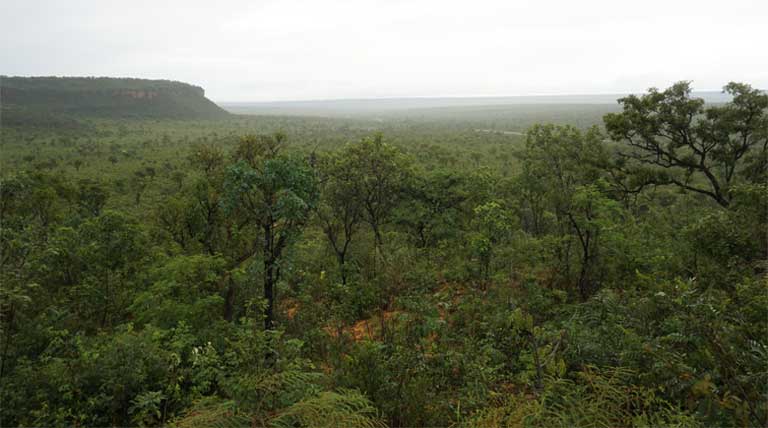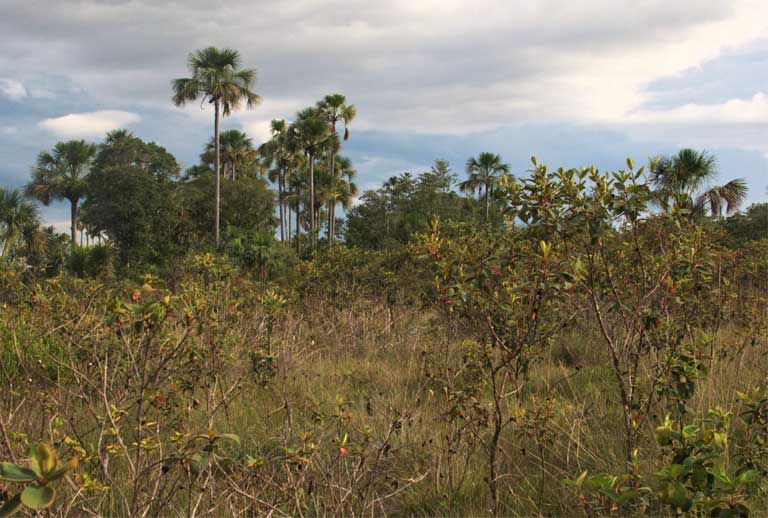
The Brazilian Cerrado is a biodiverse mixed ecosystem. It is almost three times bigger than Texas, but half of its natural habitat has been lost as it is converted to croplands and cattle pasture, and especially soy plantations. A Cerrado accord breakthrough could be at hand, conserving Brazil’s biodiverse savanna, and setting a new conservation precedent protecting its mosaic of ecosystems.
Read more
Related articles for further reading

This story was originally posted on Mongabay.
By David Cleary is Head of Agriculture for The Nature Conservancy.
- The Brazilian Cerrado is a biodiverse mixed ecosystem – a mosaic of forests, savanna and grasslands. It is huge, almost three times bigger than Texas, but half of its natural habitat has been lost as it is converted to croplands and cattle pasture, and especially soy plantations.
- in 2016, Brazil’s soy industry (via its trade association ABIOVE), joined with Brazilian NGOs to create the Cerrado Work Group. In 2017, the NGOs published a Cerrado Manifesto, stressing the need for a biome-wide conservation agreement. Many companies in the soy supply chain, including Tesco, Marks & Spencer, McDonalds and Unilever signed on.
- But a roadblock to the Brazil biome-wide agreement loomed: who would pay for zero deforestation incentives with Cerrado farmers? A breakthrough may be near: a shared incentive fund created by the dozens of companies that have signed the Cerrado Manifesto, a coalition that could include ABIOVE members, and all major global soy traders, plus impact investors.
- This sweeping Cerrado Agreement, which could be negotiated before the end of the year, would be revolutionary in that it eliminates agricultural conversion for all habitats, not just forests. This post is a commentary. The views expressed are those of the authors, not necessarily Mongabay.

An agreement on the future of the soy industry in Brazil’s Cerrado would be a very, very big deal. Here’s why. The Cerrado is huge, almost three times the size of Texas. It is a mixture of savanna, woodlands and forest with very high biodiversity. It is also the center of the largest agribusiness boom on Earth in recent decades. It now supplies much of China and the European Union (EU) with soy imports – even more so as President Trump’s tariffs increasingly restrict the flow of US soy into Asian markets.
The economic benefits for Brazil have been profound but have exacted a huge environmental cost: half of the Cerrado’s natural habitat has now been converted into cropland and pasture.
Certain companies have made deforestation commitments, but in places like the Cerrado these haven’t made much difference to the levels of habitat destruction and land conversion. Journalists, and campaigners have been pointing to the gap between the commitments and the reality of what is happening. This is where the story really begins…
In theory, there is a simple win-win scenario for the Cerrado. Plenty of land has already been cleared and converted into pasture. Enough land, in fact, to meet even Chinese demand if soy expands into pasture while ranching intensifies. But it wasn’t clear until recently how to get there.
Keen to find solutions, in 2016 Brazil’s soy industry (via its trade association ABIOVE), joined with a group of Brazilian NGOs to create the Cerrado Work Group (GTC, to use its Portuguese acronym). The following year, the Brazilian NGOs published a ‘Cerrado Manifesto’, stressing the need for an agreement. This resonated in Europe, where a group of companies signed a statement of support (SoS) for the Manifesto. Signatories included major retailers like Tesco and Marks & Spencer, alongside other major buyers of Brazilian beef and soy including McDonald’s and Unilever.
The GTC set itself a goal of reaching an agreement by the end of 2018. The challenges in making this happen were clear from the start, and surmounting these would make a formalized Cerrado Agreement even more of a big deal.

The biggest hurdle is financial. The sheer acreage of uncleared land in the Cerrado means that many farmers could still perfectly legally clear land to grow soy. If I stop clearing land, those farmers argue, there’s a cost to that. Demand for soy is high. Why should I lose income to accommodate zero deforestation targets from the SoS companies, when instead I can just sell my soy to the Chinese, who don’t worry so much about deforestation?
Here’s where the story really gets interesting. The GTC began looking at possible financial incentives for farmers to move towards zero deforestation. The current lack of such incentives has been at the core of the limited progress made to date by corporations. Driving effective change would require engaging thousands of soy farmers across the Cerrado. How can sufficient capital be mobilized to achieve this? Charging a price premium for zero-deforestation soy doesn’t work: it’s a high volume/low margin commodity. For years this has caused arguments between traders and retailers over who should bear the cost of incentivizing zero deforestation.
At last, there are signs this deadlock may be breaking. Since last month, ABIOVE has been in direct conversation with the SoS companies. The outline of a solution is on the table, and it looks like this: SoS companies pass around the hat, on a pre-competitive basis. Whatever the cost of incentives ends up being, it will obviously be lower if shared between the several dozen companies that make up the SoS coalition. The ABIOVE members, who include all the major global soy traders, would then match this sum. Finance-savvy environmental NGOs including ourselves would help SoS and ABIOVE shop this fund around the multilaterals and other impact investors, who have been dreaming of this kind of precompetitive initiative for years and would get behind it. The resulting fund would be used to put together an incentive package that encourages farmers towards zero deforestation soy.

There is not so much a devil as a whole flock of demons in the detail. How would such a fund be targeted, since habitat destruction in the Cerrado is concentrated in a few areas where money would need to be targeted? How would it be administered? What would happen to farmers who don’t meet deforestation targets? How would the fund, which would effectively need to run indefinitely, be recapitalized over time? Most pressingly, how can all this possibly be thrashed out into a binding Cerrado Agreement before the end of 2018, in line with the GTC’s self-imposed deadline? The reality is, it probably can’t. But politically, it doesn’t have to. Provided a credible process to get to a financial package is set up by the end of the year, and this package kicks in sometime during 2019, that will be enough to work with.
It’s worth dwelling for a moment on the benefits companies would receive in return for a shared investment in the Cerrado. NGOs would mobilize to help make it stick. They would help all segments of the supply chain secure independent verification of deforestation levels in soy supply chains originating in the Cerrado, finally fulfilling the potential certification schemes once seemed to offer, but haven’t delivered for soy. Fast Moving Consumer Goods companies, FMCGs, would get to meet their promise to consumers who increasingly see soy as the next palm oil. Soy traders would take a huge step forward in fulfilling their deforestation commitments, in a way that doesn’t leave farmers out of pocket.
There would be a financial cost, but it would be shared along the supply chain, and the companies would not be the only ones sharing it, which is a pretty good deal for all the businesses concerned.
Last but not least, those companies and their CEOs would be able to bask in the reputational glory of securing what would be the biggest deforestation victory of all time. Make no mistake, that is what we could be talking here because this would be the first large-scale agreement involving a core origination area for a major commodity.
Even more important, is the fact that a Cerrado Agreement would take us beyond deforestation, because it would be an agreement over land conversion, not deforestation. A problem with deforestation commitments of any kind is that they don’t eliminate pressure for habitat conversion, they merely channel it away from forests. Brazil is the best example: the risk is deforestation commitments save the Amazon at the cost of the Cerrado. But the Cerrado is a mixed ecosystem, a mosaic of forests, savanna and grasslands. Brazilian legislation makes no distinction between ecosystems in the Cerrado: farmers are regulated around native habitat in general, not forest. GTC and ABIOVE agreed from the start that a Cerrado Agreement will be about eliminating conversion of all habitats, not just forests. That is where the deforestation conversation at global level needs to go, and that is why a Cerrado Agreement would be such a massive step forwards.
More than anything, it would be proof that emerging market countries like Brazil do not face a zero-sum choice between development and conservation: there is a middle way. The ball is in the private sector’s court now. Let’s hope that everyone, across the supply chain, understands the scale of the opportunity we have in the Cerrado. Quite simply, it would be the biggest thing anyone could do in the deforestation space right now. It’s time for all the market actors to step up and make this vision a reality.
Credit:
- David Cleary is Head of Agriculture for The Nature Conservancy.
- Banner image: Cerrado panorama. Fabricio Carrijo licensed under the Creative Commons Attribution 3.0 Unported license